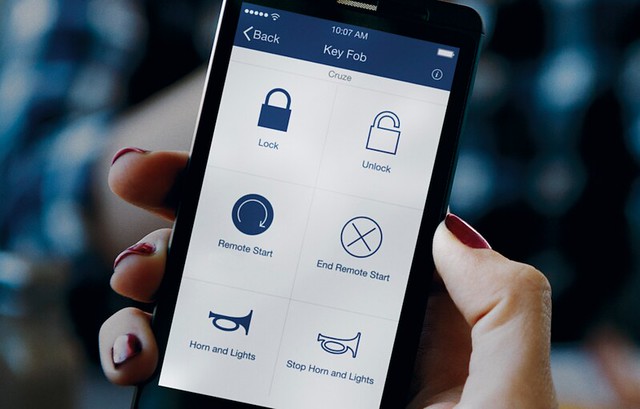Futuristic Features: What the Connected Car Looks Like Today
 If you thought blind spot sensors and rear cameras were the epitome of in-vehicle technology, wait until you climb behind the wheel of 2016 models packed with high-tech advancements to make your commute safer and more entertaining with hands-free access to information, navigation and communication.
If you thought blind spot sensors and rear cameras were the epitome of in-vehicle technology, wait until you climb behind the wheel of 2016 models packed with high-tech advancements to make your commute safer and more entertaining with hands-free access to information, navigation and communication.
In other words: the “connected car” is here.
The following is a look at a few examples of the latest in emerging automotive tech.
Apple CarPlay, Android Auto
Along with a vehicle’s integrated infotainment system, many new vehicles include support for Apple’s CarPlay and soon Android Auto, both of which make your car’s dashboard look and feel more like your smartphone’s screen.
With CarPlay, simply plug in your iPhone and put it away as it’s charging up. Now your vehicle’s dashboard will resemble your familiar iOS homescreen, showing you many supported first-party apps – like Phone, Messages, Maps, and Music – and a growing selection of third-party apps, as well. For example, you can play music from Spotify or TuneIn Radio. Say “Hey Siri,” followed by commands like “Read me my texts,” “Take me to 123 Main Street,” or “Play Sam Smith.”
When not driving, you can use the large app icons on the dashboard screen.
Google’s Android Auto is coming as well. Some vehicles will offer support for both CarPlay and Android Auto, but for some vehicles to get Android Auto you’ll need a software update to your vehicle part-way through the next year. The experience will be similar: connect your Android smartphone, say “OK Google,” followed by a question or command, and to access all of your contacts, messages, music and other info – while keeping your eyes on the road and hands on the wheel.
4G LTE Hotspots
Many new vehicles now offer support for 4G LTE connectivity.
In other words, your car is now a password-protected Wi-Fi “hotspot” that allows up to seven devices to join for Internet access. And it’s not just for the pricey premium vehicles, either. In fact, all 2016 Chevrolet models ship with this feature – even the entry-level Chevy Spark starting at under $14,000.
Drivers can access music, podcasts and audiobooks from their favourite app hands-free. Your significant other in the passenger seat can browse the web on their device and pick up email. And perhaps most importantly, kids on their tablets can stream Netflix or play an online game of Minecraft in the backseat to prevent the “Are we there yet?”
Vehicles with integrated Wi-Fi offer a much better signal than your smartphone, largely due to a powerful antenna on the roof. Plus you don’t need to use up the precious data provided by your phone and it won’t drain your smartphone’s battery as much.
With Chevy models, data packages start at a reasonable $10 per month, plus there are no roaming chargers if you want to pack the family up for a road trip through the U.S. You can also get a daily data package if you’re just doing a day trip up to the cottage.
This 4G LTE hotspot feature also works up to 50 feet outside of the vehicle, in case you want to beef up your tailgate party, cottage getaway or “glamping” adventure.
Semi-Autonomous Cars
Given the fact human error accounts for more than 90 per cent of road accidents, perhaps we ought to rely more on our vehicles to help keep us safe?
That’s the idea behind “semi-autonomous” cars. As the name suggests, the vehicle assists the driver rather than take complete control (“autonomous,” or self-driving vehicles—which are coming in a few years, too).
Adaptive cruise control is an example of semi-autonomous technology, where vehicles – embedded with cameras, radar, sonar and infrared sensors – slow down if getting too close to another vehicle (or even pedestrians at slow speeds in some vehicles) and can apply gas for you too, when needed, but help maintain a gap between you and the vehicle in front of you.
Many vehicles today can also beep if an object is detected in your blind spot, vibrate the steering wheel or seat if you’re drifting into another lane without signaling, or even parallel-park your car for you with the push of a button.
Apps and Connectivity
Finally, because many cars are now on the “grid” so to speak, many auto makers are supporting apps on a smartphone, tablet or smartwatch, to give you remote access to your vehicle.
For example, with GM’s RemoteLink, you can remotely lock or unlock the vehicle, remotely start your car, or start and stop the horn lights. In other words, consider this app an extension of your key fob.
This app can do much more, too. It can send a destination address from your phone to your vehicle before you climb behind the wheel and start the navigation. It allows you to enable or disable the 4G LTE Hotspot, change its name and password and see the status of your plan, such as how many megabytes or gigabytes you have left. It can tell you the fuel level in your vehicle, what your range is, oil life, tire pressure and for electric vehicles, the range remaining.
As you can see, car makers want you to tech out what your next vehicle is capable of. And for this self-professed geek, all of these advancements might just make me look forward to busy commutes instead of dreading them.




